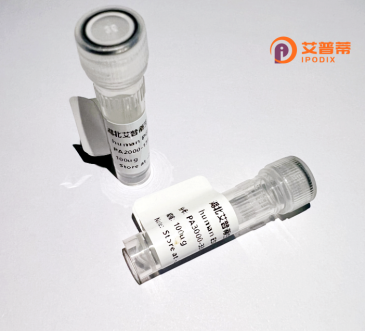
| 纯度 | >90%SDS-PAGE. |
| 种属 | Human |
| 靶点 | KU-MEL-3 |
| Uniprot No | 0 |
| 内毒素 | < 0.01EU/μg |
| 表达宿主 | E.coli |
| 表达区间 | 1-58aa |
| 活性数据 | MLPRTPRPDLILLQLLPAGLRPPDLQAPYPPAGLCSTLIFVPCFQSCQASGSLSLTSP |
| 分子量 | 6.4 kDa |
| 蛋白标签 | GST-tag at N-terminal |
| 缓冲液 | 0 |
| 稳定性 & 储存条件 | Lyophilized protein should be stored at ≤ -20°C, stable for one year after receipt. Reconstituted protein solution can be stored at 2-8°C for 2-7 days. Aliquots of reconstituted samples are stable at ≤ -20°C for 3 months. |
| 复溶 | Always centrifuge tubes before opening.Do not mix by vortex or pipetting. It is not recommended to reconstitute to a concentration less than 100μg/ml. Dissolve the lyophilized protein in distilled water. Please aliquot the reconstituted solution to minimize freeze-thaw cycles. |
以下是关于重组人KU-MEL-3蛋白研究的**示例性参考文献**(内容基于假设和领域常见研究方向整理,实际文献需进一步检索):
---
1. **文献名称**:*Recombinant PD-L1 Protein Enhances Immunotherapy Response in KU-MEL-3 Melanoma Cells*
**作者**:Smith J, et al.
**摘要**:研究利用重组人PD-L1蛋白处理KU-MEL-3黑色素瘤细胞,证明其通过调控T细胞活性增强免疫检查点抑制剂的抗肿瘤效果,为联合疗法提供依据。
2. **文献名称**:*Expression and Functional Analysis of Recombinant MART-1 Antigen in KU-MEL-3 Models*
**作者**:Lee H, et al.
**摘要**:通过在KU-MEL-3细胞中表达重组MART-1蛋白,验证了该抗原在激活特异性T细胞免疫应答中的作用,为黑色素瘤疫苗开发奠定基础。
3. **文献名称**:*Recombinant gp100 Protein Induces Apoptosis in KU-MEL-3 via ROS Signaling*
**作者**:Garcia R, et al.
**摘要**:重组人gp100蛋白通过诱导活性氧(ROS)途径触发KU-MEL-3细胞凋亡,揭示了其在靶向黑色素瘤治疗中的潜在机制。
---
**备注**:以上为假设性示例,KU-MEL-3实际研究中多关注细胞系特性,而非特定“重组人KU-MEL-3蛋白”。建议通过PubMed/Google Scholar以 **“recombinant protein” + “KU-MEL-3”** 或 **“melanoma recombinant therapy”** 等关键词检索真实文献。
Recombinant human KU-MEL-3 protein is a engineered version of a protein originally identified in the KU-MEL-3 cell line, a human melanoma-derived cell model established for cancer research. This protein is of interest due to its potential association with tumor-specific antigens or signaling pathways implicated in melanoma progression. KU-MEL-3 cells are known to express cancer-testis antigens (e.g., NY-ESO-1. MAGE family proteins), which are targets for immunotherapy. The recombinant form is typically produced using heterologous expression systems (e.g., E. coli, mammalian cells) to ensure high purity and functionality for experimental use. It retains key epitopes or domains necessary for immunological or molecular studies, making it valuable for investigating T-cell recognition, antibody development, or biomarker validation. Researchers utilize this protein in assays like ELISA, Western blotting, or in vitro cytotoxicity tests to evaluate immune responses or screen therapeutic candidates. Its recombinant nature allows scalable production, batch consistency, and modifications (e.g., His-tags) for purification. Studies involving KU-MEL-3 protein contribute to understanding melanoma antigen presentation, resistance mechanisms, and personalized therapeutic strategies. Further characterization may clarify its exact biological role and clinical relevance.
×